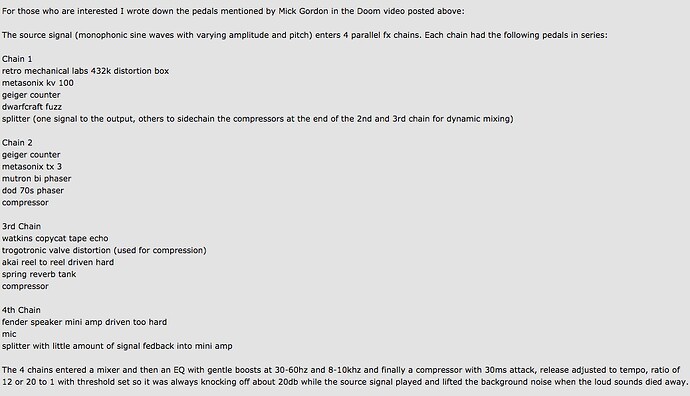I would like to create (classic) feedback circuits with effects / modulator … both simple and more complex but as I start with audulus and I do not understand how to create this circuit. I tried with the various mixer proposed but I can not do anything.
Do you have any advice or examples to offer? thank you in advance
What type of feedback are you looking for?
I am looking to do feedback circuits with delay / reverb / distortion and other effects. In another case I would like to “replicate” the Mick Gordon feedback circuit for the Doom video game.
List of pedal
So, something that sounds like distorted guitar feedback?
yes !
guitar feedback sound.audulus (143.2 KB)
This is the patch I have been using lately, you can control the pitch with any 1/Oct signal and experiment with effects.
You can also check out the library delay modules inside and copy and paste their feedback loops.
Thanks a lot !
Is there a technique to create a feedback loop with the available modules? Without having to use the nodes?
I don’t understand, modules are the same as using nodes. I honestly am unsure what you are asking for, so the best I can do is show you some of my favorite patches that sound like or use feedback.
delay feedback.audulus (40.7 KB)
Here is a delay-based feedback patch for you. It has a filter in the feedback loop that makes a tone when you feed noise into the system.
thanks again.
What I would like to replicate is a feedback loop in the same style as when chaining effect pedals (delay, distortion …) with a mixer using auxiliary inputs outputs.
The Aalto synth has an amazing thing called the waveguide/delay that has a great resonant quality and can achieve feedback-like sounds. Has someone implemented something like it using Audulus?
Just discovered Steve Schoen’s 10 Band Resonant equalizer which has a lot of the qualities that I was looking for.
According to the documentation, the Aalto waveguide is a delay with a peaking EQ and wave shaper in the feedback loop. Not many details on the wave shaper other than it adds both even and odd harmonics. The peaking eq is some form of peaking filter, maybe a biquad. and the delay is “interpolated” which allows for delay values that are not multiples of the sample rate. I’m not sure what advantages if any this might offer in practice. You could certainly model something like this using the delay node and a feedback loop.
Your resonant equalizer satisfies the itch that I had for an Aalto like resonator/feedbacker. I really love it. I coaxed some interesting sounds out of it by using its output to modulate some knobs (including its own). (Speaking of which, I’ll be sad when we can’t use anything to modulate anything just by wiring signals to knobs).
This might still be up in the air, but regardless, if we go through with that, each knob will have a modulation input, so it will basically work the same ![]()
I would gladly trade the ability to directly modulate a knob for the ability to export a sub-module’s UI. With a practical way to “normal” an input, I don’t think it will be much of a handicap. In any case I don’t think any of the details of the UI have been finalized at this point.
Cool! That will be even better.!
Agreed re: using a sub-module’s ui.
@biminiroad If the ability to wire directly to the knob is removed, could we still have the visual aspect of the automated knob moving to the modulation remain? I think the biggest draw for me to the direct wire-to-knob modulation is the visualization of what the modulation signal is doing to the affected module.
But that’s for builders, what about the users? I don’t have analytics, but I suspect most people want a friendly patching environment and are happy to let others build.
You could be right. I’m not sure what form that knobs will finally take, but I feel certain that we will still be able to modulate things. A workable normal would let you interrupt a knob with an external signal and might be more flexible.

